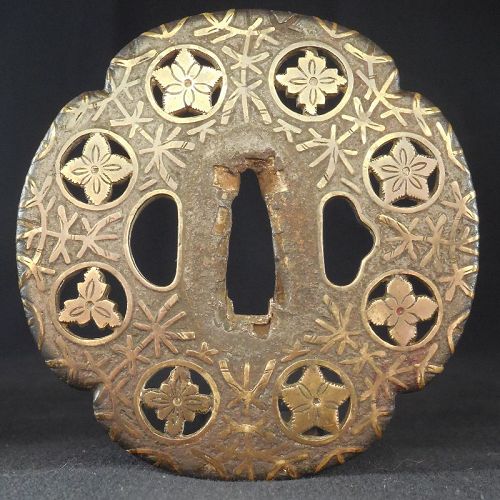This tusba is of the Yoshiro-zogan style. It issues from the Heianjo-zogan (inlaid tsuba of the so named city in Mino province - not the jidai [period]) but demonstrates an evolution in design and execution. In both styles, work originating from the Muromachi period were brass inlaid iron. At the time, brass was more scarce than gold and was considered quite valuable - more so according to some literature. The Yoshiro style is named for an artist of Echizen (or Kaga) who worked in the 16th century. While Heianjo-zogan tsuba had inlay higher than the surface of the iron plate, Yoshiro-zogan inaly was comparatively flush with the iron surface of the plate accomplishing a relatively smooth feel. The designs also evolved from the Heianjo to the Yoshiro style. The algae and sukashi mon devices shown here are distinctively Yoshiro-zogan in manner. The sparse missing inlay is actually quite modest and some inlay loss is expected from brass inlaid tsuba from the Muromachi period (1392-1573).
In both styles, work originating from the Muromachi period were brass inlaid iron. At the time, brass was more scarce than gold and was considered quite valuable - more so according to some literature. The Yoshiro style is named for an artist of Echizen (or Kaga) who worked in the 16th century. While Heianjo-zogan tsuba had inlay higher than the surface of the iron plate, Yoshiro-zogan inaly was comparatively flush with the iron surface of the plate accomplishing a relatively smooth feel. The designs also evolved from the Heianjo to the Yoshiro style. The algae and sukashi mon devices shown here are distinctively Yoshiro-zogan in manner. The sparse missing inlay is actually quite modest and some inlay loss is expected from brass inlaid tsuba from the Muromachi period (1392-1573).
 |

